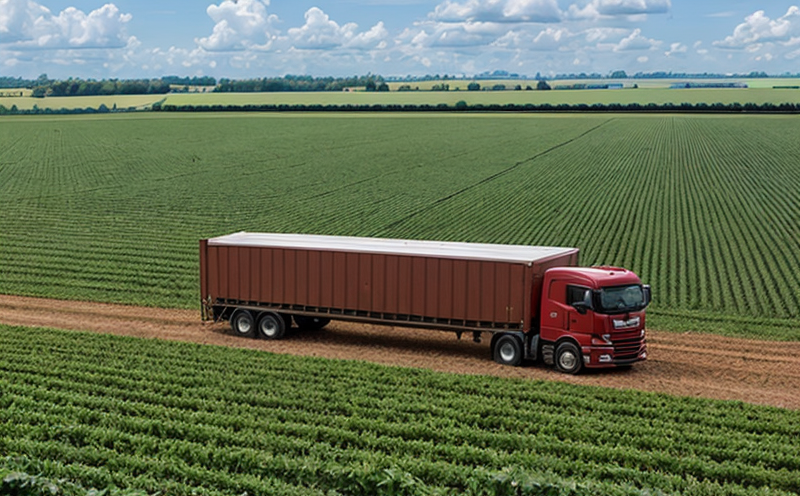Drop Test for Agricultural Product Packaging
The drop test is a crucial method in ensuring that packaging designed to protect agricultural goods during transport and storage can withstand various environmental stressors. This service specifically focuses on assessing the resilience of packaging materials used in agriculture, including fruits, vegetables, grains, and other perishable items. The objective is to determine whether the packaging will remain intact under simulated transportation conditions, thereby protecting the integrity of the goods.
Drop tests are conducted by exposing packages to controlled impacts from a specified height using standardized equipment such as drop towers or impact testers. These tests replicate real-world scenarios where products may experience falls due to handling errors, accidents, or rough transit. The primary goal is to evaluate how well the packaging can protect the product's quality and safety.
The testing process involves selecting appropriate specimens that accurately represent the intended agricultural goods. Specimens are typically placed inside the packaging under test conditions that mimic their expected environment during transport. This includes factors like temperature, humidity, and exposure time prior to the drop impact. The equipment used for these tests adheres strictly to international standards such as ISO 16758-2 which provides guidance on shock testing of packages.
For accurate results, it is essential that both the packaging materials and contents are prepared according to established protocols. This ensures consistency across multiple trials so that any observed damage can be attributed directly to the impact rather than variations in preparation methods. After each test run, detailed reports are generated detailing the extent of any damage sustained by both the packaging itself as well as the agricultural goods within.
Understanding environmental factors is also critical when designing effective drop tests because they influence how sensitive products behave under stress. For instance, moisture content affects the elasticity and strength properties of certain materials which could impact their ability to absorb shock energy during impacts. Therefore, understanding these variables helps tailor testing parameters more precisely for different types of agricultural produce.
Accurate data collection is vital throughout this entire process since it allows manufacturers to make informed decisions about improvements needed in future versions of packaging designs. By incorporating feedback from such tests into product development cycles, companies can continuously enhance their offerings leading ultimately towards higher customer satisfaction levels and increased market competitiveness.
Why It Matters
The success of agricultural businesses heavily depends on the quality and safety of their products reaching consumers. Ensuring that packaging meets all necessary standards not only protects against potential losses but also builds trust with customers who value freshness and integrity above all else.
In today’s competitive markets, non-compliant packaging can lead to significant financial penalties or even reputational damage if recalls occur due to compromised product quality. Implementing robust testing procedures helps mitigate these risks early on in the supply chain process. Additionally, meeting regulatory requirements demonstrates a commitment to responsible practices which can enhance brand image and foster long-term relationships with suppliers and clients.
Furthermore, effective packaging contributes significantly towards reducing waste by extending shelf life and preventing spoilage during transit. This reduces both operational costs associated with replacement orders as well as environmental impacts linked to discarded products that haven't reached their intended destinations.
Customer Impact and Satisfaction
By investing in comprehensive drop testing services, customers gain peace of mind knowing that their investments are protected through rigorous quality assurance measures. This translates directly into enhanced customer satisfaction because satisfied clients are more likely to return for future purchases or recommend your products/services to others.
For businesses operating within the agricultural sector, this means increased profitability through reduced waste and improved operational efficiency. Moreover, companies that prioritize sustainability will find themselves better positioned against emerging trends in eco-friendly practices favored by modern consumers.
In summary, implementing robust drop testing ensures not only compliance with regulatory requirements but also contributes positively towards overall business performance metrics like customer retention rates and market share growth.
Environmental and Sustainability Contributions
Reduces waste: Properly designed packaging helps minimize spoilage, thereby reducing the amount of food wasted during transportation.
Promotes recycling: Using sustainable materials in packaging encourages proper disposal practices, promoting recycling efforts.
Decreases carbon footprint: By optimizing transport routes and methods based on tested data, overall emissions can be minimized.
Saves resources: Efficient packaging minimizes the use of raw materials needed for production, conserving natural resources.
The environmental benefits extend beyond immediate operational impacts; they contribute to broader sustainability goals aligned with global initiatives like reducing greenhouse gas emissions and preserving biodiversity.





